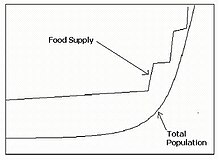We have already begun talking about the food supply and its unequal distribution. Now let’s discuss the issues arose by this problem and how do they are handled.
Stuff and terms that you might want to know 
Food security. This expression means that every person in a given area has a daily access to enough nutritious food to have an active and healthy life.
Food insecurity. The opposite of the first one. There are not enough food supply or simply people have not the needed resources to access them.
*This two guys are directly related to the poverty and most be treated by the government in order to secure the insecure and maintain the security.
|
Undernutrition. The food consumed doesn’t provides enough energy.
Malnutrition.
Food has enough energy but lacks certain essential vitamins, minerals or proteins.
Overnutrition.
The food consumed exceeds energy use and causes excess of body fats. Yeah… Not big deal in the LEDC’s but we need to take it into account.
Some of the essential components needed to avoid malnutrition are:
Lack of Iron: “Derives into a case of anemia (lack of iron). Increases fatigue, risk of infection and mortal danger at childbirth”. It is necessary for the hemoglobin which captures oxygen and derives it around the body.
Lack of Vitamin A. “More likely to get sick or die of common infectious diseases (flu, diarrhea, measles). Blindness” - retina, thus eye-sight dependents on it Vitamins are nutrients, but a catalyzer to the absorption of nutrients.
Lack of Iodine. Affect the processes of the metabolism. It causes stunted growth, metal |
Famine. A famine is a situation of severe shortage of food supply in an area accompanied by mass starvation, many deaths, economic chaos, and social disruption. It is typically generated by a catastrophic event.
*It is important to analyze famines’ impact over societies and the environment. Obviously there is a great disruption over the social structure of the community. Food becomes the main asset and its acquisition the final goal. The power if for whom has the control over the limited food supply.
The environment is harmed by the reaction of the population against the famine. People start to slaughter their livestock and grains and, instead of rationalized it, they finished up the remaining food supply. |
Now that we know what’s the roll with this terms we can analyze
the situation and present the actual management of the issues.
ACTUAL SCENARIO
We have already discuss the possible causes of this unequal food distribution in a
previous blog entry. Let’s extended this explanation.
Our food supply is generated in both terrestrial and aquatic systems.
From the terrestrial systems we get grains and other crops, and livestock. Most of the world population’s diet is based upon wheat, rice and corn. As the income of certain sectors of the population increases, more meat and livestock's derivate products, such as milk and cheese, are consumed.
Aquatic systems generate food supply based on fish and shellfish.
It depends on the resources of each community or country which is its main source of food. But these three are the BIG THREE of food supply.
Now, the roll must go back a little bit. By talkin’ about the terrestrial systems of food production, we must take into account the different agricultural techniques that are being used…

















